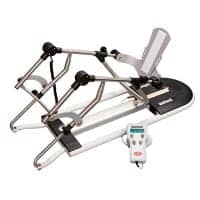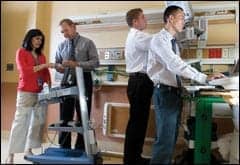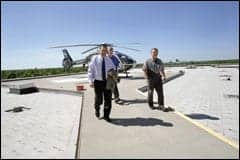 |
| Bob Deeter, St John’s LifeLine pilot (right) discusses operational service processes with the CE team, Chris Nowak (left) and Dan Mills (center), as they exit the helipad. |
There is a certain freedom that comes with doing it all. Having the in-house resources to solve a problem means the problem can be solved quickly and efficiently, resulting in little impact on patient care as well as the bottom line. This is especially true for health systems located in smaller cities and regions, where manufacturer representatives and other technical service people tend not to be located.
As regional director of Mercy clinical engineering services, Christopher G. Nowak, CBET, oversees service to the facilities of St John’s Health System and Mercy Health System of Kansas that are located in the organization’s Springfield, Mo, and Kansas strategic service units. These include eight hospitals and nearly 100 clinics covering a large geographic region, with the main campus located in Springfield.
“We are about 3 hours away from St Louis, 3 hours away from Kansas City, 3 hours away from Tulsa, and 3 hours away from Little Rock,” Nowak says. “The manufacturers tend to staff in those big cities rather than the city of Springfield, so we would always be waiting if we had to have an OEM rep show up.”
System downtime can be costly, both to patient care and in revenue generation, and delays are not ideal. In addition, an in-house team can often deliver better service. When Nowak’s team wants to manage a new modality in-house, it puts together a service delivery plan that details the improvements that will occur in care delivery and service cost. “We show them what we are currently spending on contractual obligations, system downtime, and materials, and how much money and time we can save,” Nowak says.
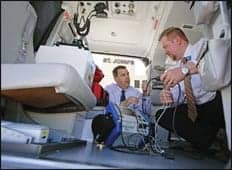 |
| Above: L-R: Chris Nowak, CBET, and Matt Morelock, CBET, discuss the defibrillator setup in LifeLine 1, one of the three helicopters that have clinical device assets managed by the St John’s CE team. Below: Chris Nowak, CBET, and Bob Deeter, St John’s LifeLine pilot (right) outside one of the three helicopters |
 |
The in-house clinical engineering team can respond much more quickly, increasing system uptime, improving patient care, and reducing associated costs. The administration has supported many of the proposals, and the clinical engineering division now handles most of the institution’s service needs.
“There’s not a single thing we don’t touch,” Nowak says, listing traditional biomedical engineering devices, imaging devices, clinical laboratory devices, radiation oncology devices, nurse call, infant security systems, CCTV systems, paging systems, and television distribution systems. Nowak estimates the clinical engineering inventory includes nearly 30,000 pieces of equipment.
Of course, there are challenges to delivering such a broad range of services to the large inventory, but the team manages with flexibility. With an eye toward value, Mercy clinical engineering services is willing to take on new responsibilities, even those that fall outside of the traditional biomed function. The team does everything it can to build the necessary expertise to meet these demands, including bringing on new staff, providing training for existing personnel, and collaborating with other departments.
The Right Stuff
The right team is key to succeeding at new objectives and will offer the depth to increase the clinical engineering department’s ability to respond to the institution’s departmental needs. “We just don’t want to have one person hold all the knowledge. If Joe goes on vacation and they call Susie up with a ventilator problem, she can’t say she has never seen one before,” Nowak says. Rather, everyone on the Mercy clinical engineering team—35 full-time employees—is cross-trained.
“We can at least look at a problem on any type of equipment, and we don’t have to say we are not trained on it and won’t look at it,” Nowak says. The health system supports continued education and new training with both time and dollars. Educational opportunities are selected based on the needs of the organization.
Nowak uses a new radiation oncology system with a $260,000 full-service contract as an example. The clinical engineering department presented a business case that illustrated the cost of in-house service versus waiting for a manufacturer engineer.
“By having someone trained on-site, the machine is getting worked on immediately or within minutes, rather than in 3 or 4 hours or the next day,” Nowak says. “So we make a business case to the administration showing that if we pay for somebody to go out to school on this machine, we will save $100,000 a year or $50,000 a year—whatever that business model might point to.”
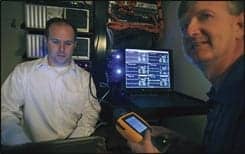 |
| L-R: Matt Dunbar, CBET, and Dan Mills, CBET, validate a patient monitoring network infrastructure. |
Similar cases are made for bringing in new modalities, although those business plans also may include new staff in addition to new training. Dan Mills, CBET, biomed technician III for Mercy clinical engineering services, has been with the institution long enough to see it expand into new areas like imaging and the clinical laboratory. “We needed a lot more training and a lot more staff to handle these more specialized items,” Mills says.
Recruiting can be a challenge, particularly in terms of building the right team. The right players must possess a variety of skills—both technical and interpersonal. “You can have Albert Einstein working for you, but if he is not a good person, or he’s not able to communicate, or he’s not able to interact with other human beings, it doesn’t matter how good that person is; it doesn’t work all the time,” Nowak says. “So it is important that you have the right team put together.”
Networking is an ideal way to find new hires, since references can help to avoid “bad eggs.” The wrong hire can be expensive both in terms of recruitment costs and morale impact.
Meeting of the Minds
Interpersonal skills are as essential as technical skills because biomeds need to be able to successfully interact and communicate with health professionals throughout the hospital—from clinicians to information services (IS). “It’s up to me as a biomed to do what I can to communicate effectively with them,” Mills says. “I’m there to serve them and do my best to understand what they want and what they need.”
Conflict is often the white elephant in the room, but successful biomed departments manage to put it aside and foster collaborative relationships. The Mercy clinical engineering team has embraced this philosophy, successfully implementing a number of projects with an interdepartmental effort. Open communication keeps everyone working together.
“We need to know how to talk to each other because we all have our own lingo and our own jargon and sometimes we get moored in that environment,” Nowak says. “This way, it allows us to really broaden our relationships and our knowledge by being able to ask the right question the right way.”
Willing collaboration has led to the successful sharing of ongoing responsibilities as well as the implementation of new projects, the most recent of which was the installation of a wireless pulse oximetry system. Mercy clinical engineering services partnered with the Mercy information systems division to enable continuous monitoring of patients on a pediatric unit.
Due to remodeling, the pediatric unit had to change floors. To maintain the pulse oximetry monitoring system, the clinical engineering department was looking at pulling the network cabling of an entire occupied nursing unit. Infection control issues would add another obstacle to the project. With the help of IS, the teams could avoid all this and even expand the system’s capabilities.
“Wi-Fi allowed us to put the monitoring in place without having a lot of infection control issues or general labor and materials costs,” Mills says, who credits IS with helping to accomplish the objective wirelessly. “From my standpoint, we didn’t have any major hurdles.”
The biggest challenge for IS, according to Ian Flanders, manager of network services for Mercy’s information systems division, was expected to be related to inadequate system support for the team’s authentication methods. “We use two of the stronger methods available, and not every product supports this,” Flanders says. However, the problem was minimized, and the project proceeded smoothly.
The end result has been a reliable system—clinical engineering has not yet received any service requests—and has expanded clinical capabilities. Patients can now be monitored off the floor—for instance, while in radiology. “It was a phenomenal opportunity for us from a patient care perspective,” Flanders says.
It is the objective of delivering excellent patient care that drives the teams to work together and share responsibility. Where clinical engineering and IS networks overlap, the two must work together to resolve problems when necessary.
“We try to maintain our patient monitoring network entirely, but if we’ve determined a problem is on an IS network, we’ll work with them to get the problem resolved,” says Matt Dunbar, CBET, biomed technician III with Mercy clinical engineering services.
For instance, clinical engineering will handle the first screening call on the new pulse oximetry wireless monitoring system. “If it’s something where we think it might be some sort of networking issue, then we would contact IS,” Mills says, adding he would bypass their help desk and connect directly with an IS team member.
In the past, the two groups did not work together so easily and were a little more protective of turf and reputation, but that was then. Working together today, solutions can be found more quickly than working separately. “We need each other, and we need to figure out how to help rather than build up those turf wars,” Flanders says.
“I think it’s incumbent upon biomeds that we get more knowledgeable in the information system world so we can communicate with them effectively—so we can tell them what we need and they can understand it,” Mills says.
Flanders and Nowak lead their teams by example, collaborating frequently. They also strongly encourage any team members to work out any problems, perhaps over lunch every day until the conflict is resolved. “It’s family in a way, with patient interest at the end,” Flanders says.
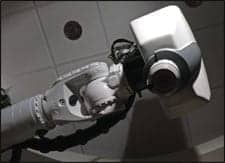 |
| Above: The Accuray CyberKnife—poised and ready for cancer treatment. Below: The St John’s Health System CyberKnife. It uses high doses of radiation with submilimeter accuracy to treat tumors anywhere in the body. |
 |
A Can-do Attitude
Delivery of quality patient care drives not only collaboration but also departmental excellence. The Mercy clinical engineering services department is always willing to take on new responsibilities, even those that many biomeds consider out of their realm.
“I hear guys say they don’t want to get involved in IS or they don’t want to fix beds or tables or sterilizers, and I chuckle because it just creates another opportunity for us to add more value to our institution and the patient who comes in the front door and it pays our salary,” Nowak says.
Refusing to take on additional work will force the institution to find someone else to do it and “maybe one day, replace your position,” Nowak says. But a strong in-house department that adds value on a daily basis is unlikely to be unseated by a third party or a manufacturer, particularly when that value improves care and revenue.
Cabling offers an excellent example. The Mercy clinical engineering team pulls, certifies, and documents its own fiber and copper cable. “Some biomeds might think pulling their own cable is a rather mundane process and may be beneath them, but we look at it much differently than that,” Nowak says.
One important benefit is control. By doing it themselves, Mercy’s biomeds can ensure the job is done right and facilitate troubleshooting when problems arise. “Since we are pulling our own cable and documenting it, we know exactly where that cable or fiber is run, how it’s terminated, and other things like that,” Nowak says.
The network’s reliability improves, and so does the team’s reputation. “When we hand cable over to IS to plug into the port on their router or hub or switch, they can be assured that everything behind that is properly terminated, properly pulled, and meets all the specifications and guidelines that they require on their end,” Nowak says.
The clinical engineering department will often even verify that a cable is appropriate with IS before purchasing and installing it, having learned the hard way that approved cable has been tested and had its operation certified. “Anytime we run cable we clarify with IS that it’s the proper cable and up to their specifications, so there is no finger-pointing if something doesn’t work in the end,” Dunbar says.
Handling cable in-house has also saved money. Pulling cable can be pricy, and if the service can be managed in-house the institution has more dollars to put toward the device being purchased. “A lot of departments or facilities don’t want to run fiber optic because they think it is too fragile to install or too expensive,” Dunbar says. “But now that we can do it in our department, it really saves a lot of money and opens up a lot of possibilities on our network infrastructure.”
|
Read past department profiles in the archives. |
The convenience is another benefit. Immediate service can help to get a system up and running sooner. “If we need a temporary install, we can get it done that day. We’re not waiting on a third-party vendor to schedule that and come in,” Dunbar says.
Once again, it is the do-it-yourself attitude that gives the team this freedom. Open to new responsibilities, new ideas, new training, and new collaborations, Mercy clinical engineering services delivers consistent value to the health care institutions it serves and the patients it treats.
Renee Diiulio is a contributing writer for 24×7. For more information, contact .



